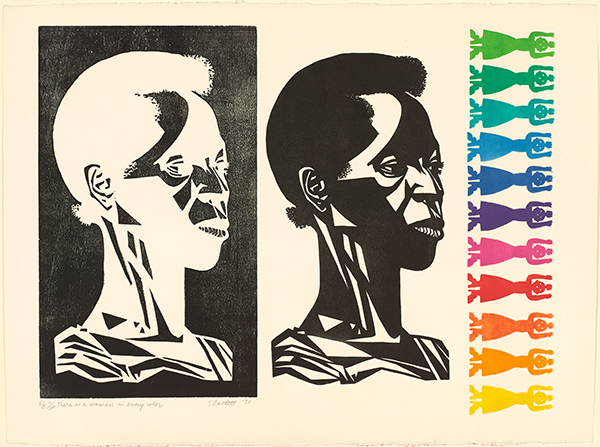There Is a Woman in Every Color: Black Women in Art
Bowdoin College Museum of Art • Brunswick, ME • bowdoin.edu/art-museum • Through January 30, 2022

In her lithograph, etching, and chine collé print Blue Plate Special, 1993, Alison Saar riffs on the classic motif of the head of St. John the Baptist on a plate. Exhibition curator Elizabeth S. Humphrey speculates that by Saar’s “coding the decapitated head as African American—through the darkened skin tone and hair style—and the use of the phrase ‘Blue Plate Special’—referencing the low-priced meals available in American diners,” the viewer is “meant to interpret this work as a commentary on the violence and undervaluing of Black people and their bodies.”
Part of the mission of Humphrey’s remarkable exhibition is to highlight the undervaluing of Black women in art. Drawing primarily from the Bowdoin Museum, she highlights both the limited inventory—less than 1% of the permanent collection features Black women—and the power of what is there. The more than 60 artworks, which include paintings, prints, photographs, sculptures, and artist books, covers more than two centuries of Black women artists’ contributions and how they have been represented in art.
The title of the show comes from Elizabeth Catlett’s 1975 color linoleum cut, screenprint, and woodcut There Is a Woman in Every Color. Humphrey ties the positive/negative face of a Black woman and the line of colorful stick figures to Catlett’s call for racial equality.
Visual echoes happen from room to room. One instance: the Kara Walker linoleum cut African/American, 1998 showing a woman falling through space lines up with Julie Mehretu’s four-part multi-color aquatint and spit-bite Myriads, Only by Dark, 2014. Using a cut-out silhouette and abstract markings, respectively, both artists reflect what Mehretu refers to as “self-ethnography.”
Humphrey’s show is part of a needed trend to shine a spotlight on art-historical omissions (see, for example, the new installation at the Met, Before Yesterday We Could Fly: An Afrofuturist Period Room). We have a long way to go to make up for lack of Black representation in our art institutions. This exceptional exhibition helps us get there.
[There Is a Woman in Every Color travels to the El Paso Museum of Art.]
—Carl Little
